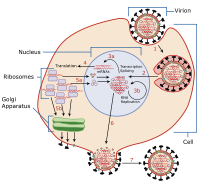Viral replication
Viral replication is the formation of biological viruses during the infection process in the target host cells. Viruses must first get into the cell before viral replication can occur. From the perspective of the virus, the purpose of viral replication is to allow production and survival of its kind. By generating abundant copies of its genome and packaging these copies into viruses, the virus is able to continue infecting new hosts. Replication between viruses is greatly varied and depends on the type of genes involved in them. Most DNA viruses assemble in the nucleus while most RNA viruses develop solely in cytoplasm.
Viruses multiply only in living cells. The host cell must provide the energy and synthetic machinery and the low molecular-weight precursors for the synthesis of viral proteins and nucleic acids.
The virus replication occurs in seven stages, namely;
The virus attaches itself to the Cell Membrane of the host cell. It then injects its DNA or RNA into the host to initiate infection.
The cell membrane of the host cell invaginates the virus particle, enclosing it in a pinocytotic vacoule. This protects the cell from antibodies like in the case of the HIV virus.
Cell enzymes (from lysosomes) strip off the virus protein coat. This releases or renders accessible the virus nucleic acid or genome.
For some RNA viruses, the infecting RNA produces messenger RNA (mRNA). This is translation of the genome into protein produces. For others with negative stranded RNA and DNA, viruses are produced by transcription then translation.
The mRNA is used to instruct the host cell to make virus components. The virus takes advantage of the existing cell structures to replicate itself.
...
Wikipedia

